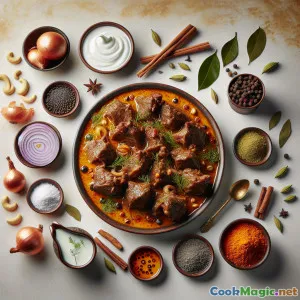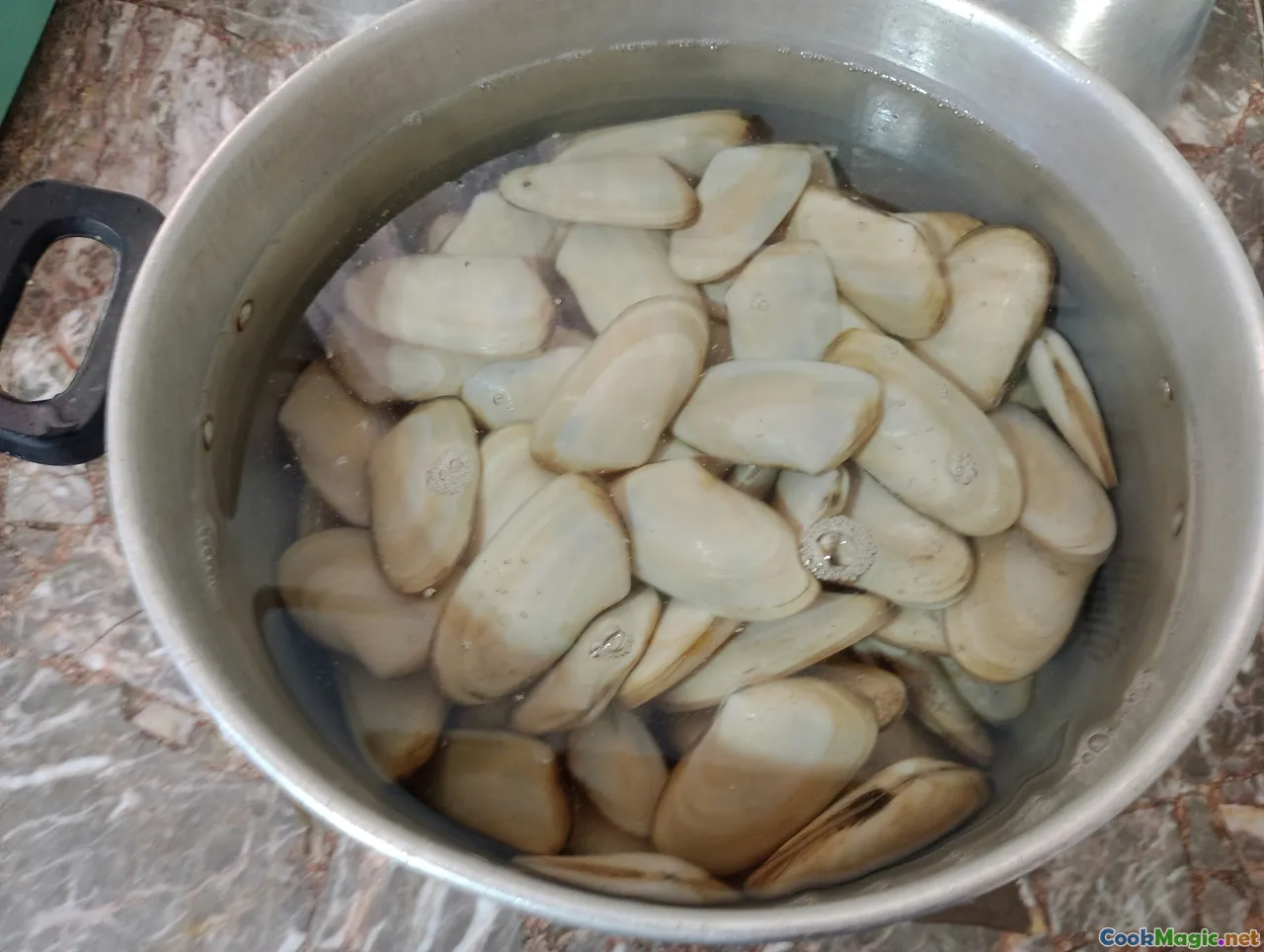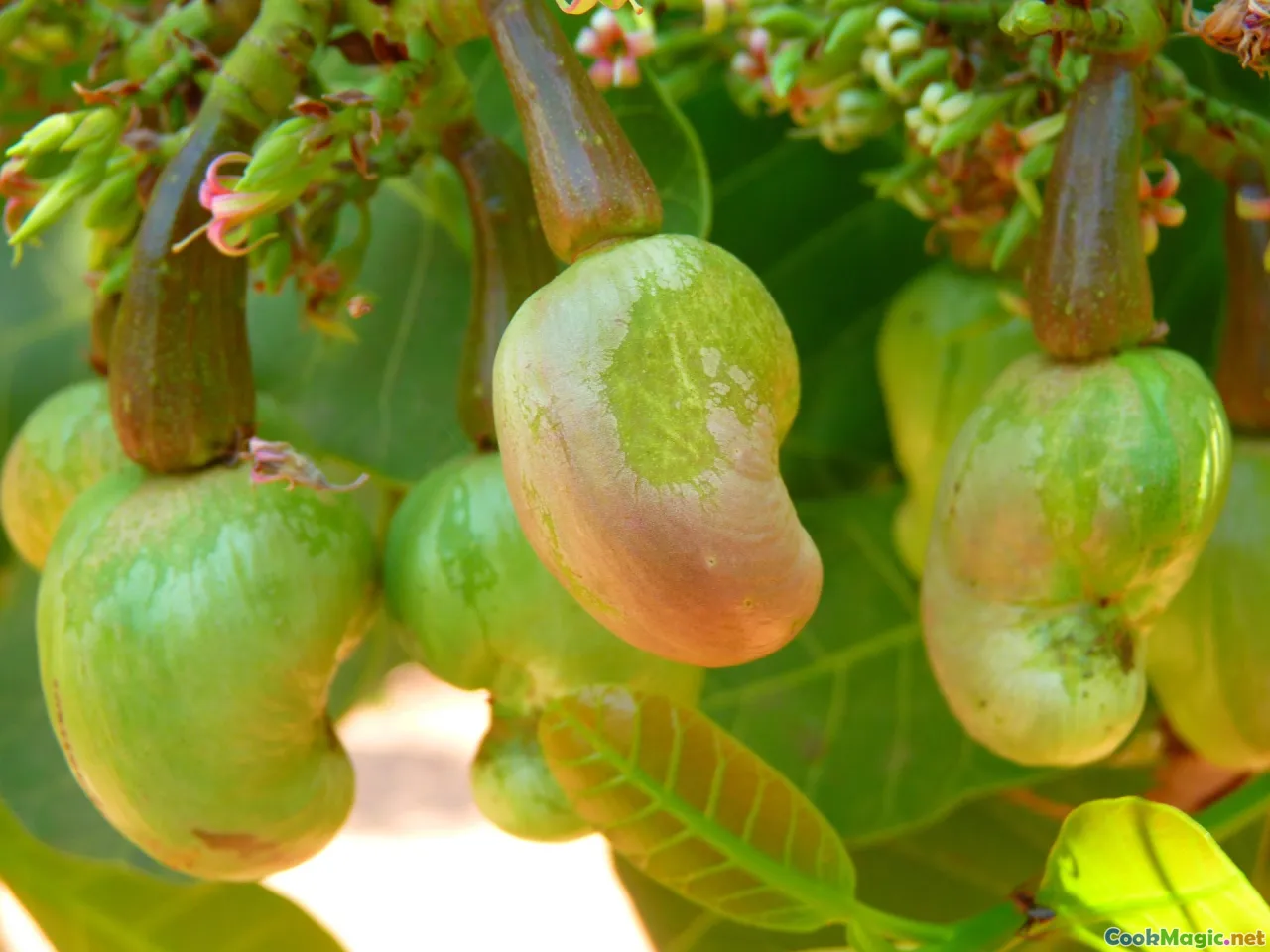
Ujawnione Królewskie Radżastańskie Białe Curry z Jagnięciny
(Royal Rajasthani White Mutton Curry Unveiled)
(0 Recenzje)0
1,019
lipiec 17, 2025
Zgłoś problem
Składniki
-
600 grams Jagnięcina (z kością)
(Poproś o kawałki o średniej wielkości; jeśli to możliwe, używaj organicznych składników.)
-
2 medium Pasta z cebuli
(Białe cebule, preferowane, drobno zblendowane.)
-
60 grams Nerkowce
(Namocz i zmiel, aż uzyskasz gładką pastę.)
-
20 grams Nasiona maku
(Namoczony i zmielony, hojnie używany w królewskich sosach.)
-
120 grams Świeży jogurt
(Śmietanka pełnotłusta, dobrze ubita.)
-
3 tbsp Ghee (oczyszczony masło)
(Autentyczny smak; można zastąpić 1 łyżką oleju.)
-
4 pieces Ziarenka zielonego kardamonu
-
3 pieces goździki
-
1 inch piece Laska cynamonu
-
6 pieces Ziarna czarnego pieprzu
-
1 piece Liść laurowy
-
2 tbsp Pasta imbirowo-czosnkowa
(Świeży, najlepiej domowej roboty.)
-
100 ml Mleko
(Dodaje kremowość.)
-
1 tsp Mąka z białego pieprzu
(Do podgrzewania bez zmiany koloru.)
-
1 pinch Gałka muszkatołowa
(Świeżo starty, opcjonalny, ale zalecany.)
-
1 tsp Woda kewra
(Dla aromatycznej, kwiatowej nuty; woda różana może być substytutem.)
Sól, to taste
-
2 tbsp Świeża śmietana
(Na wykończenie.)
-
2 sheets Liść srebrny (varq)
(Do królewskiej dekoracji. Pominąć, jeśli nie jest dostępna.)
-
1 tbsp Świeże liście kolendry
(Drobno posiekane, do dekoracji.)
(Poproś o kawałki o średniej wielkości; jeśli to możliwe, używaj organicznych składników.)
(Białe cebule, preferowane, drobno zblendowane.)
(Namocz i zmiel, aż uzyskasz gładką pastę.)
(Namoczony i zmielony, hojnie używany w królewskich sosach.)
(Śmietanka pełnotłusta, dobrze ubita.)
(Autentyczny smak; można zastąpić 1 łyżką oleju.)
(Świeży, najlepiej domowej roboty.)
(Dodaje kremowość.)
(Do podgrzewania bez zmiany koloru.)
(Świeżo starty, opcjonalny, ale zalecany.)
(Dla aromatycznej, kwiatowej nuty; woda różana może być substytutem.)
(Na wykończenie.)
(Do królewskiej dekoracji. Pominąć, jeśli nie jest dostępna.)
(Drobno posiekane, do dekoracji.)
Wartości odżywcze
- Porcje: 4
- Wielkość porcji: 1 miska (250g)
- Calories: 550 kcal
- Carbohydrates: 21 g
- Protein: 32 g
- Fat: 37 g
- Fiber: 2.5 g
- Sugar: 6 g
- Sodium: 740 mg
- Cholesterol: 110 mg
- Calcium: 140 mg
- Iron: 3.2 mg
Instrukcje
-
1 - Oczyścić i przygotować baraninę:
Dokładnie umyj kawałki baraniny i dokładnie osusz je. Odstaw na bok. Zacznij namaczać nasiona maku i orzechy nerkowca w letniej wodzie, aby uzyskać pastę.
-
2 - Wymieszaj pasty:
Zmień namoczone nerkowce i nasiona maku na gładką pastę, w razie potrzeby dodaj odrobinę wody. Osobno zblenduj białą cebulę.
-
3 - Smażyć całe przyprawy:
Podgrzej ghee na ciężkiej patelni. Dodaj kardamon, goździki, cynamon, czarny pieprz i liść laurowy. Niech skwierczą, aż uwolnią aromat.
-
4 - Mieszanka cebuli z jogurtem:
Dodaj pastę z cebuli, smaż delikatnie, aż aromat złagodnieje, a mieszanka stanie się przezroczysta. Dodaj pastę imbirowo-czosnkową i podsmażaj, aż lekko się zrumieni. Wmieszaj jogurt, gotuj na małym ogniu, aż tłuszcz się oddzieli.
-
5 - Zrumień baraninę i zamknij soki w mięsie:
Dodaj kawałki mięsa baraniego na patelnię, smaż na dużym ogniu przez kilka minut, aż zbrązowieją ze wszystkich stron.
-
6 - Dodaj pasty z orzechów i przyprawy:
Wmieszaj pastę z nerkowców i nasion maku, sól, biały pieprz i odrobinę gałki muszkatołowej. Niech wszystko połączy się na małym ogniu przez 5–6 minut.
-
7 - Duś na małym ogniu aż do doskonałości.:
Wlej mleko i około 1,5 szklanki wody. Przykryj i gotuj na małym ogniu przez 50–60 minut, aż baranina będzie miękka jak masło, a sos zgęstnieje.
-
8 - Ostatnie Szlify:
Wyłącz ogień. Wymieszaj świeżą śmietanę kremówkę i delikatnie dodaj wodę kewra dla aromatu. Spróbuj doprawić solą.
-
9 - Dekoracja i podanie:
Łyżką przełóż na półmisek, ułóż błyszczące srebrne liście i posyp posiekaną kolendrą. Podawaj na gorąco, z sheermal lub aromatycznym ryżem.
Dokładnie umyj kawałki baraniny i dokładnie osusz je. Odstaw na bok. Zacznij namaczać nasiona maku i orzechy nerkowca w letniej wodzie, aby uzyskać pastę.
Zmień namoczone nerkowce i nasiona maku na gładką pastę, w razie potrzeby dodaj odrobinę wody. Osobno zblenduj białą cebulę.
Podgrzej ghee na ciężkiej patelni. Dodaj kardamon, goździki, cynamon, czarny pieprz i liść laurowy. Niech skwierczą, aż uwolnią aromat.
Dodaj pastę z cebuli, smaż delikatnie, aż aromat złagodnieje, a mieszanka stanie się przezroczysta. Dodaj pastę imbirowo-czosnkową i podsmażaj, aż lekko się zrumieni. Wmieszaj jogurt, gotuj na małym ogniu, aż tłuszcz się oddzieli.
Dodaj kawałki mięsa baraniego na patelnię, smaż na dużym ogniu przez kilka minut, aż zbrązowieją ze wszystkich stron.
Wmieszaj pastę z nerkowców i nasion maku, sól, biały pieprz i odrobinę gałki muszkatołowej. Niech wszystko połączy się na małym ogniu przez 5–6 minut.
Wlej mleko i około 1,5 szklanki wody. Przykryj i gotuj na małym ogniu przez 50–60 minut, aż baranina będzie miękka jak masło, a sos zgęstnieje.
Wyłącz ogień. Wymieszaj świeżą śmietanę kremówkę i delikatnie dodaj wodę kewra dla aromatu. Spróbuj doprawić solą.
Łyżką przełóż na półmisek, ułóż błyszczące srebrne liście i posyp posiekaną kolendrą. Podawaj na gorąco, z sheermal lub aromatycznym ryżem.
Więcej o: Ujawnione Królewskie Radżastańskie Białe Curry z Jagnięciny
Safed Maas Sheherwali Style: A Regal Heritage on Every Plate
Introduction & History
Safed Maas Sheherwali Style is not simply a dish; it epitomizes the confluence of Rajasthani royalty and unique Sheherwali Jain cultural influences that thrived in Murshidabad—once Bengal's seat of power and multicultural splendor. Traditionally, 'Safed Maas' in Rajasthan signifies a mutton curry solely bathed in white gravies, eschewing red chilies and vibrant spice blends for slivers of subtlety and aromatics. The Sheherwali community, celebrated for their mercantile nous and discerning finesse, reflected their regal opulence in banquets interwoven with Mughal and Marwari essence.
What Sets Sheherwali Safed Maas Apart?
This rendition’s reverent homage to timeless princely kitchens lies in its orchestral balance: a medley of nuts—cashew and poppy seed paste—enrich the velvety gravy, harmonizing with mellow yogurt, floral spices, and an occasional kiss of rose. Unlike the fiery red gravies, this one seeks a gentle elegance, letting the tender mutton and creamy sauce sing. What truly distinguishes the Sheherwali style is:
- Refusal to use regular red chili, turmeric, or harsh garam masala.
- Joyous embrace of mild white pepper, aromatics, nuts, and flower essences.
- Frequent use of a touch of floral (often kewra or rose) water for fragrant finish.
- Optional application of shimmering silver leaf (‘varq’) for special feasts.
Cooking Secrets, Tips, & Personal Notes
Meat Selection: How the mutton is cut matters. Choose pieces with bone—the slow, hour-long simmer is what yields a gravy bursting with flavor and the supremely tender characteristic of no-nonsense regal curries.
Cashew-Poppy Paste: Ensure both nuts and seeds are soaked for at least half an hour to ensure smoothest grinding. A fine, velvety paste prevents grittiness in that prized white gravy.
The Aromatic Difference: Frying whole spices in ghee initiates the dish’s symphony. Control the flame and sauté aromatics gently to repel bitterness from onions and garlic.
Milk & Yogurt Marriage: To master a shamelessly lush yet subtle sauce, you must balance milk and yogurt, whisking slowly into the base to avoid curdling.
Garnishing with Class: For formal occasions, delicate sheets of edible silver leaf leave a striking impression and hint at the aristocratic table.
Accompaniments: Sheherwali Safed Maas is customarily enjoyed with sheermal (sweet saffron flatbread), soft naans, or plain fragrant basmati. When seeking contrast, jeera rice punctuates the meal’s richness.
If you crave a vegetarian tweak, simply substitute paneer chunks or boiled potatoes and use the core technique.
Cultural Significance
Though Sheherwali cuisine for the most part follows Jain vegetarian laws, at grand social functions or interactions with the Rajasthani nobility, such royal celebratory non-veg dishes were nuanced for a gentle, extravagant palate. Carefully balanced spices and an absence of overbearance honor ancient codes of hospitality, appeasing both privilege and probity. They stand as a testament to the meld of Jain thought, royal opulence, and Mughal artistry.
Final Musings & Aspects
If you seek to wow guests with an unforgettable feast in a velvet white, this dish will become a party centerpiece. It’s a paean to delicate flavors over unrestrained heat. Its silken texture—lavished with nuts and milk—soothes, yet leaves a savory trailing note, gently coaxed upward by keora’s floral finish.
For best results:
- commit to slow-cooking;
- be gentle when adding milk or yogurt;
- don’t skip the little musk of nutmeg or the sweet floral note at the end.
Whether for a winter gathering or a festive thali, Safed Maas Sheherwali Style will transport your table across time, drawing every guest into a world where flavor, refinement, and festivity reign.























